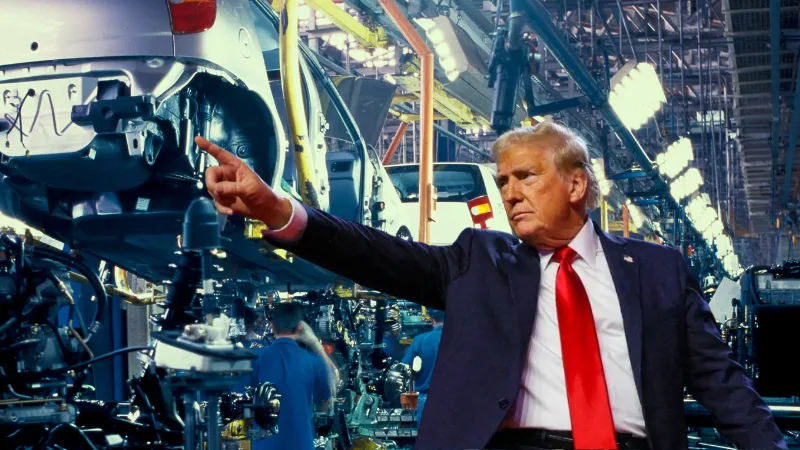In a significant move aimed at alleviating mounting pressure on the U.S. automotive industry, President Donald Trump signed an executive order on April 29, 2025, that eases some of the tariffs imposed on auto parts and vehicles. The decision marks a strategic pivot just over 100 days into Trump’s second term, as his administration seeks to maintain pressure on foreign trade partners—especially China—while softening the economic blow on American businesses and consumers.
Trump’s Executive Order on Auto Tariffs
The order modifies the structure and scope of existing automotive-related tariffs that were implemented under Trump’s aggressive trade agenda. Here’s a breakdown of what’s changing:
Tariff Credits for Domestic Auto Assemblers
Auto manufacturers that assemble vehicles in the United States will now be eligible for tariff relief through a credit system:
- In the first year, automakers can receive credits equal to 3.75% of the retail price of vehicles assembled domestically.
- In the second year, the credit drops to 2.5%, encouraging a phased adaptation to sourcing more U.S.-based components.
- The credits are retroactive to April 3, 2025, offering immediate financial relief to qualifying manufacturers.
Elimination of Tariff Stacking
Previously, vehicles and parts could be hit with multiple tariffs—25% on autos, 25% on steel and aluminum, and more if sourced from countries like China. This executive order eliminates such “stacking,” which often doubled or tripled the cost burden for manufacturers. Instead:
- Only the highest applicable tariff will be levied.
- Components from countries like Canada and Mexico that meet USMCA (United States-Mexico-Canada Agreement) requirements will remain exempt.
No Relief for Chinese Imports
While North American supply chains benefit from this order, the tariff regime on China remains aggressive:
- Many Chinese auto parts still face tariffs of up to 145%, continuing Trump’s pressure campaign on Beijing to reduce trade imbalances and alleged intellectual property violations.
Why This Matters: The Stakes for the Auto Industry
The U.S. automotive industry has been under pressure for years from rising raw material costs, semiconductor shortages, and increasingly complex trade policies. These tariffs—initially introduced as a way to promote domestic manufacturing—have become a double-edged sword.
Industry Reaction
Automakers and parts suppliers have largely welcomed the changes:
- General Motors, Ford, and Stellantis issued statements supporting the move, noting that the adjustments provide “breathing room” to reconfigure supply chains without sacrificing profitability or jobs.
- Industry lobbying group Alliance for Automotive Innovation called the changes “a smart recalibration that reflects both economic realities and national security goals.”
Expert Opinion
According to Dr. Marianne Keller, a trade economist at Georgetown University:
“This move is about threading the needle. Trump wants to look tough on China while also calming down an increasingly nervous manufacturing base ahead of a possible economic slowdown.”
She warns, however, that this is a “temporary fix” and that auto manufacturers will still need to localize more of their supply chains to remain competitive long-term.
What Does This Mean for Consumers?
Short-Term Relief on Car Prices
The most immediate effect for consumers is likely to be stabilization in vehicle prices, which had been rising sharply due to tariff-related cost increases. However, don’t expect major discounts just yet.
- Cars already on lots were imported or assembled under previous tariff conditions.
- Automakers may use the credits to improve margins rather than cut sticker prices.
No Relief on Chinese EVs or Batteries
Electric vehicles (EVs) and battery components from China remain under steep tariffs, which could keep prices high for EVs—especially those in the sub-$40,000 segment. This could slow EV adoption in the U.S. unless domestic battery production scales up significantly.
How Investors Should Interpret This
Stock Market Reaction
Shares of major U.S. automakers rallied slightly following the announcement:
- GM rose 1.4%
- Ford gained 2.1%
- Tesla, while less impacted due to its vertically integrated U.S. operations, climbed 0.7%
Auto parts suppliers like BorgWarner and Magna International also saw modest gains, anticipating smoother logistics and more predictable sourcing costs.
Winners and Losers
Winners:
- U.S.-based automakers with high domestic content (Ford, GM)
- North American parts suppliers
- Investors in logistics and manufacturing automation firms
Losers:
- Chinese parts suppliers targeting U.S. manufacturers
- EV startups reliant on Chinese batteries
- Consumers expecting quick price drops in the auto market
Sector Rotation Potential
This policy change could spark a rotation into domestic manufacturing stocks—especially companies involved in robotics, automation, and domestic logistics that will help U.S. automakers localize production faster.
Broader Economic and Political Context
This move comes at a pivotal moment. President Trump is trying to balance multiple, often conflicting, goals:
- Maintain U.S. manufacturing jobs
- Keep consumer inflation in check
- Punish Chinese economic behavior
- Deliver on “America First” trade promises
He has faced increasing pressure from both Wall Street and Main Street. Business leaders have warned that unchecked tariffs could tip the U.S. into a recession, while voters in auto-heavy states like Michigan and Ohio are watching closely as jobs hang in the balance.
According to The Washington Post, the administration has described the changes as “strategic easing” that aligns with national security while preventing an economic overcorrection.
What’s Next?
The executive order includes a built-in review mechanism:
- If U.S. auto content levels increase meaningfully by mid-2026, credits may be extended or expanded.
- If not, tariffs could snap back to full strength, particularly for companies not making demonstrable efforts to shift their sourcing strategies.
Meanwhile, trade negotiations with China remain stalled, and no new dialogue is scheduled. Trump’s team continues to explore broader tariffs in sectors like consumer electronics and pharmaceuticals.
Surrender?
Trump’s move to ease auto tariffs is not a surrender—it’s a tactical recalibration. It aims to support American manufacturers without giving away leverage in broader trade wars, especially with China. For investors, this is a bullish signal for the U.S. auto sector in the short to medium term. But the long-term implications will depend on how quickly companies adapt and whether new trade disputes emerge.
As always, investors should watch for:
- Supply chain developments
- Changes in U.S.-China relations
- Inflation data and consumer sentiment
- Sector-specific earnings reports
If you’re holding or eyeing auto-related stocks, now is the time to dig into company filings and listen closely to earnings calls. This executive order might offer temporary relief, but it also underscores how fast trade policy can shift under Trump’s second term.





